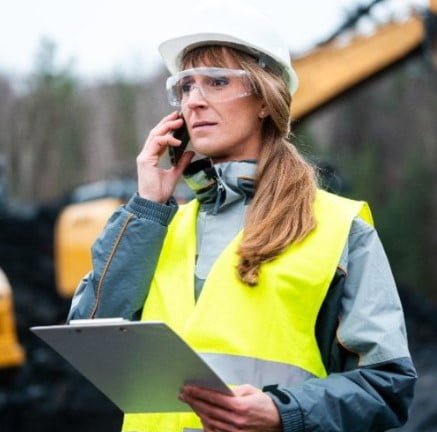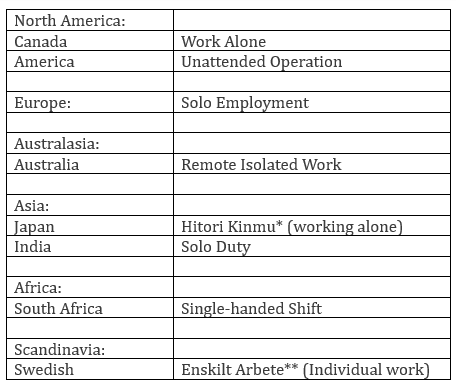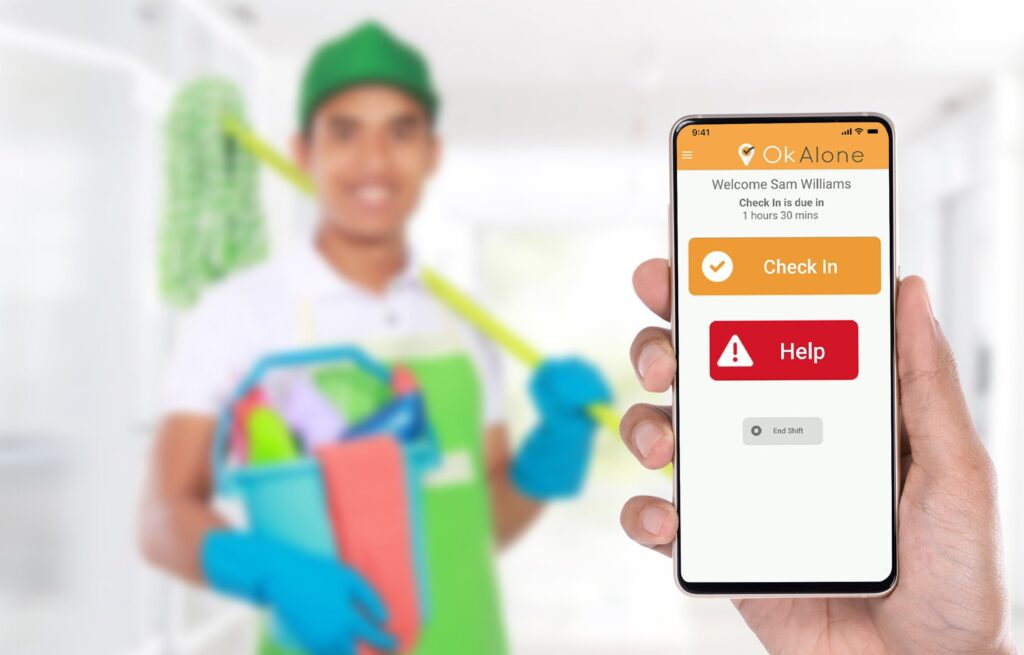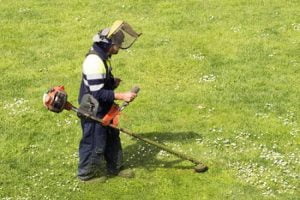The Different Terms Used for Lone Working Around the World

Lone working, the practice of employees working alone or without direct supervision, is a common occurrence across various industries and regions around the world. Whether it's a night-shift security guard, a remote field researcher, or a healthcare professional visiting patients' homes, lone working represents a significant aspect of the way people work today.
The terminology used to describe this practice can vary widely, reflecting the diverse nature of jobs, cultures, regulations, and business environments. Understanding these terms is not just a passing interest; it's a crucial part of recognizing the unique challenges and safety considerations associated with lone working.
This article aims to explore the myriad terms and phrases used to describe lone working, delving into sector-specific language and regional variations, technological advances and legal perspectives to provide a comprehensive guide to this subject.

General Terms and Phrases for Lone Working
The term "Lone Working" itself is likely the most common and universally understood term used to describe the practice of employees working without direct supervision. It's a straightforward expression that clearly conveys the concept, and is used across many industries and regions.
Other terms like Working Alone or Solo Work might also be commonly understood as well as Unsupervised Work, Single-Person Work, Independent Technician, Unaccompanied Work, Isolated Worker, Self-managed Work, Independent Work, Individual Work, Autonomous Work and Solitary Work. The terms all give a clear idea that a person is either alone on location or completing a task without the assistance of others.
There is one term that has evolved over the last few years changing its meaning. Before the pandemic the term Remote Worker meant someone that tended to work on sites or locations that were hard to get to and where no other people were in the vicinity. For example, someone collecting data from a weather station or taking samples from a riverside ecosystem.
However, since the pandemic and the meteoric rise of working from home, these terms – Working Remotely and Remote Worker have been applied to someone who works from their own home. They are remote from the workplace, keeping in contact with colleagues and management online. This person is still a lone worker however, as they do not have co-workers in the same location.
Technically these people are 'Teleworking' which is in the same vein as Remote Working as it allows employees to carry out their duties and responsibilities from an offsite location other than their official workplace. It could involve working from home, another branch office, café, bookstore, or even a co-working space.
Though often away from the office, a teleworker is different from a remote employee because there is occasionally some in-person office attendance required — though this is not always the case. Another key difference is that a teleworker is often geographically closer to the main office location than a remote worker. Teleworking is an ideal option for tasks or jobs that require writing, research, reading, data analysis, computer work, telemarketing, etc.

Sector-Specific Terms for Lone Working
Within different industries there are specific terms used to describe the role or act of lone working.
Within the Healthcare industry the terms Community Nurse, Home Health Visitor and On-Call Doctor are all roles carried out by solo staff.
Construction or Maintenance tasks carried out by an individual, especially during off-hours or in remote locations are done on a Single Worker Site or by a Solo Operative.
For people working alone in scientific fields they are referred to as doing Field Research or Solo Exploration.
On offshore platforms used by the Gas and Oil industry an individual responsible for monitoring equipment or processes is Solo Watchkeeping.
Security personnel working alone, especially during night shifts or in isolated locations are Lone Guarding or on Solo Patrol.
Single-Handed Farming and Lone Farming are terms used for Farmers or Agricultural workers who manage tasks alone, particularly on small or family-run farms.
The retail industry frequently has instances of single staffing or lone retail workers when staff are the only employee on site, especially during unsociable hours.
Solo Logging is a term that refers to individuals working alone in the Forestry industry.
Those who drive for a living in the Transportation industry are known to be either Solo Driving or Independent Driving.
Solo Maintenance and Independent Technician are terms used to describe HVAC or Utilities workers when they do a job on their own.
Real Estate agents are almost always alone during their work day, frequently going to meet clients alone in empty properties. Within their industry they are known as carrying out an Individual Property Inspection or being Lone Property Management.
Emergency Services personnel, like paramedics, who might respond to calls alone, particularly in remote or sparsely populated areas are Solo Response or an Independent Responder.
The concept of people working alone in Offices, whether after hours or at isolated sites, is recognized within various professional environments. Though there might not be a universally used single term for this practice, several phrases and descriptions are used to convey the idea: After-Hours Work, Isolated Office Work, Lone Office Worker, Solo Office Shift and Unsupervised Office Work. While commonly associated with working from home, Remote Office Work could also describe working in a physically remote or isolated office location.

Country and Regionally Specific Terms
Around the world there are also different terms and phrases used to identify someone who completes work by themselves. The terms and practices associated with lone working can vary widely reflecting local labour laws, industrial practices, cultural nuances, and language differences. Many of the terms are the same as used across the various industries above, however, here are some of the more unusual terms used in different locations:

Technological Advances and Lone Working
The increasing popularity of lone working across various industries has led to the development and adoption of specialized technologies that ensure the safety and well-being of lone workers. These technologies range from simple alerting mechanisms to complex, integrated systems that provide real-time monitoring and assistance. The monitoring mechanisms might include regular check-ins, wearable safety devices, GPS tracking, panic buttons and other technologies or procedures tailored to the unique risks and needs of lone workers.

A large number of lone workers use a working alone app on their smartphone to enhance their safety. The apps offer features like regular check-ins, panic buttons, GPS tracking, high-risk settings, voice commands and man down. They are widely used across many industries such as retail, healthcare, construction and more due to their convenience and accessibility.
Wearables can include smartwatches, badges or lanyards with built-in alarms, location tracking, and biometric monitoring. This form of monitoring is particularly popular in industrial settings like manufacturing, mining and oil & gas where rapid response to accidents and awareness of a worker’s health status is crucial.
Trucking, delivery services and field technicians often use Vehicle-mounted systems that show the position of their vehicle and provide tracking and communication. They can also have features like route monitoring and emergency alerts.
Call Centres often work in tandem with apps or devices to provide 24/7 human monitoring and support. Used across a wide range of industries, for an additional layer of safety and immediate response, they access worker or companywide escalation procedures to direct their responses to the right person.
Another aspect of technology that is used to support lone workers is the development of Data Analytics. Predictive analytics and AI algorithms can analyse worker behaviour and environmental conditions to predict and prevent potential risks. This form of proactive safety measures builds on reports and data from past events or near misses to avoid future incidents.
The wide variety of technologies available for lone worker safety reflects the diverse needs and challenges faced by different industries. These tools provide not only immediate response capabilities but also long-term data and insights that can help organisations develop safer working practices.

New Language Developed Through Technological Advancements
Technology is not only providing new tools and systems to support lone working but is also shaping the very language and practice of how we approach work without direct supervision.
| Old Practice | New Language | Impact | |
| Redefining Safety Protocols | Basic check-ins or manual reporting. | "real-time monitoring," "automatic alerts," "fall detection" and "geo-fencing" | Shift from mere compliance to proactive safety management. |
| Enhancing Communication | Isolated with limited means of communication. | "Two-way communication," "video check-ins" and "instant messaging" | Constant connectivity, reducing isolation, allowing immediate response to concerns or incidents. |
| Data-Driven Decisions | Limited information or anecdotal evidence. | "Predictive analytics," "behavioural monitoring" and "risk assessment algorithms" | Precise understanding of risks allowing for targeted interventions and training. |
| Remote Training and Support | Not specific to unique working conditions | "Virtual Reality training," "Augmented Reality support" and "personalized digital guidance" | Enables tailored training experiences for their specific roles. |
| Integrating with Broader Ecosystems | A separate concern, disconnected from others | "Integrated safety platforms," "ecosystem connectivity" and "IoT-enabled devices" | More cohesive and efficient approach to overall safety. |
Technology is not just adding new tools to the toolkit of lone working; it's fundamentally reshaping how we think about, talk about, and practice working alone. The language has evolved to reflect a more complex, nuanced, and proactive approach, recognising the diverse needs and potentials of lone working across various industries. By transforming the vocabulary and practices, technology is helping to create a safer, more connected, and more responsive environment for lone workers, recognizing their unique contributions and challenges within the modern workplace.

Legal and Regulatory Perspectives
Much like the terms differing from place to place or industry to industry, the legislation and legalities of an employer’s responsibility to their lone workers also differ depending on where they are located.
The approach to lone worker legislation varies widely, from detailed and specific laws to more general requirements within broader occupational health and safety frameworks. The common theme is a recognition of the unique risks faced by lone workers and a legal expectation that employers will comply with their duty of care and take appropriate steps to mitigate those risks.
The Occupational Safety and Health Act (OSHA) 1970 requires employers in the United States to provide a safe working environment for all their employees, including lone workers, but there is no specific federal law for lone workers.¹
Within Canada several provinces, such as British Columbia, Alberta, Saskatchewan and Manitoba have detailed lone worker regulations requiring risk assessment, check ins and having a suitable means of communication that must be adhered to. Other provinces and territories might not have specific lone worker legislation but will include general provisions within their occupational health and safety regulations that cover the safety and well-being of lone workers.²
The Health and Safety at Work Act 1974 and the Management of Health and Safety at Work Regulations 1999 include provisions related to lone worker safety in the United Kingdom. Employers are required to conduct risk assessments and implement appropriate safety measures for lone workers.³
Within the European Union (EU), lone worker safety is generally encompassed within broader occupational health and safety regulations, guided by the Framework Directive on Safety and Health at Work (Directive 89/391/EEC). However, a few countries such as Germany and France have implemented guidelines, codes of practice or specific provisions within their occupational health and safety laws that address the unique risks and requirements associated with lone working. While specific legislation on lone working might not be widespread across Europe, the general principles of risk assessment, prevention, and worker well-being are enshrined in the broader legal framework and apply to lone workers as well.
The Model Work Health and Safety Act 2011 in Australia includes requirements for managing risks to lone workers. Other states within Australia including New South Wales, Victoria, Queensland and Western Australia all have their own local lone worker legislation, that include conducting risk assessments, maintaining communication and responding to emergencies.⁴
It is interesting to note that regardless of terms used in different industries all of the countries referred to the employees as ‘lone workers’ within their legislation, but then qualified that by referring to locations (remote or isolated) and proximity to other workers (cannot be seen or heard).

Compliance
As an employer there is a duty of care towards all employees and a responsibility to ensure staff have adequate training and equipment to minimise risks at work. Company directors must provide a safe working environment, including any necessary protective equipment, and a safe workplace. Companies need to make sure they are compliant with guidance set out by their governments and duty of care responsibilities to keep their workers safe.
Conclusion
This article has provided a comprehensive look at the diverse terminology of lone working. With a detailed focus on sector-specific language and regional variations, we have highlighted the broader social, technological, and legal contexts that shape the language and practice of lone working.
It is important that the terms used to describe those who work alone are universally understood in order to provide additional support to those lone working, and ensure companies comply with any local legislation.
Book a Demo Today
Alternatively, get a free trial of the app
Want to try OK Alone? Click the button below and enter your details. It's free and no credit card is required.





